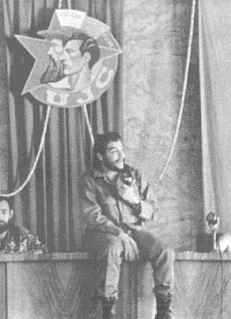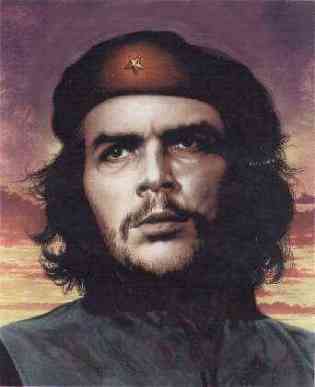Cuba, the rebel
Thus, on January 3rd, 1961
USA breaks diplomatic relationships with Cuba and this is getting
closer increasingly to the USSR, now in the military field. Cuba
also would refine Soviet crude oil. In Cuba sabotages were
increased, many of them supported by the USA State Department
that was supporting the anti-Castro exiles. On February 23th, Che
is selected to direct the Industries Ministry that centralizes
many nationalized companies. On April 17th approximately 1500
anti-Castros from Florida, Puerto Rico, and Nicaragua disembark
in PLaya Girón or Bay of Cochinos attempting to overthrow the
government. Che is quartered in Pinar del Río and is nominated
responsible of the West sector including La Habana. Bay of Pigs
shows a discredit for a disorganized mercenaries army supported
by Washington against a patriot people and a State for them
rebellious. Castro leaves strengthened and the measures of the
government are radicalized. On August 4th, Che heads the Cuban
delegation in Punta del Este and is received in a very friendly
way  by a multitude in
Montevideo. Predicts failure for the Alliance For the Progress,
that includes all the Latin American governments except Cuba.
Meets presidents Brazil's Janio Quadros, Uruguay's Eduardo Haedo
and Argetina's Arturo Frondizi; two of them would have to pay the
price for receiving Che: Quadros is overthrown that week with the
pretext of have decorated a communist and Frondizi faces a
military coup seven months later.
by a multitude in
Montevideo. Predicts failure for the Alliance For the Progress,
that includes all the Latin American governments except Cuba.
Meets presidents Brazil's Janio Quadros, Uruguay's Eduardo Haedo
and Argetina's Arturo Frondizi; two of them would have to pay the
price for receiving Che: Quadros is overthrown that week with the
pretext of have decorated a communist and Frondizi faces a
military coup seven months later.
Cuba faces the "brains flight" and there are just some few heads capable to direct the State. The imported machines from eastern Europe were of less quality than the USA's or the Japanese ones and it's hard for a nation that is struggling against an embargo and working with pieces rejected by the USSR. In January, 1962, the OAS expels Cuba. Camilo, second son of the marriage with Aleida, borns on May 20th. In June, Fidel accepts the installation of Soviet missiles in Cuba as a response to those missils installed by USA in Turkey. August 2th Che undertakes a tour trying to reach economic agreements; is received in the USSR and in Czechoslovakia. August 31th, Che subscribes the missils agreement with Kruschev in Crimea, USSR. The tension between the two superpowers grows so much that this period would be known as "the crisis of the missiles". On October 22th, John F. Kennedy, announces to the people of USA about the situation and demands the USSR to withdraw the missiles; in the negotiation, the USSR relinquishes in exchange for a USA deflection on their missiles from Turkey and on not to attack Cuba, an event that marks a deep deception inside Che who is moved away from Moscow postures. It's here where the popular phrase emeerges "Nikita, mariquita(little fagot), what is given must not be retired".
In April 1963, Celia de la Serna, Che's mother, is arrested in Argentina by presumed pro-Cuba propaganda distribution. On June 14th is born his third daughter, Celia, in honor to Che's motherly grandmother. Visits Algeria in July.
In January 1964 travels
to Moscow and procures a commercial agreement and a communique in
favor of peaceful coexistence. In March accomplishes a work tour
by Switzerland, France, Czechoslovakia and Algeria. Guevara plans
the actions of an insurgent group headed by Masetti that is
liquidated in April 1964 by the Argentine security forces. Visits
Moscow on November 4th, 1964, as a beginning of a long three
months tour by all over the world. December 11th marks his
presentation  before the General Assembly of the
United Nations heading the Cuban delegation with a heavy
anti-imperialistic speech; attacks the Latin American
oligarchies, USA and its colonial system, makes mention to the
Congo's leader Patrice Lumumba murdered in 1961, exposes in favor
to the independent and freedom struggles. He's distinguished by
his figure before the solemn formality of the enclosure and the
gowns of those who fill it. On December 18th arrives to Algeria
and meets Ahmed Ben Bella, leader of the Algerian independence.
before the General Assembly of the
United Nations heading the Cuban delegation with a heavy
anti-imperialistic speech; attacks the Latin American
oligarchies, USA and its colonial system, makes mention to the
Congo's leader Patrice Lumumba murdered in 1961, exposes in favor
to the independent and freedom struggles. He's distinguished by
his figure before the solemn formality of the enclosure and the
gowns of those who fill it. On December 18th arrives to Algeria
and meets Ahmed Ben Bella, leader of the Algerian independence.
On January 2nd, 1965, begins a work trip by Tanzania, Egypt, Mali, Ghana, Dahomey and probes the possibility of start an insurgent area fight in África. Cuba is a kind of an economic hostage of the USSR exporting basically sugar and diplomatic relationships get tight at the same time that moves away from China; with the absence of Che in Cuba, commercial agreements are signed which go against the industrialist project defended by Guevara. On February 24th, borns his son Ernesto while travels from Cairo to Algeria. The following day attacks severely the countries of the Soviet block in the "Speech of Algiers" by not solidarize with freedom struggles. When he returns to Cuba, March 15th, he's carried to a "closed doors" court accompanied by Dorticós and Raúl Castro due to the Speech of Algiers. He had already decided to depart course to the Congo and quit Cuba, maybe due to ideological disputes with Fidel Castro and Raúl Castro, one of the nearest guy to Moscow. On March 31th gives Fidel a leave-taking letter that would mean Che's destination. On April 1st, marches toward África characterizing a false personage in order not to recognize it. On April 24th, he arrives to the Congo together thirteen Cubans. On May 19th his mother dies. In June starts to operate in the Congo but shows disappointed by the comforts demanded by the guerilla leaders and their lack of discipline. Toward the end of October, Fidel Castro reads the Che's leave-taking letter during the act of foundation of the Cuban Communist Party: in it, Che resigns to his military rank, his Cuban nationality, his position, his family inclusive. Before the scarce results, the Cuban group abandons the Congo. Laurent Desireé Kabila, guerrilla who was operating in the north and east part of the country would reach power in 1997.
On January, 1966 the Congress of the "++Tricontinental" is accomplished in La Habana. Che's found surreptitiously in Tanzania and is visited by Aleida. After Congo had marked Che's first guerrilla stumble, goes to Praga as unknown where passes three months in the middle of an appartment. He was preparing there to light one more guerrilla but is discarded due to the recent Argentina Massetti's failure, therefore chooses Bolivia where insurgents would have to be detached toward Peru and Argentina. Links with Tamara Bunke, the secret agent, tight. In July returns to Cuba to prepare the mission that would depart to Bolivia. On November 3th arrives to Bolivia with false documents representing Adolfo Ore, a fictitious OAS official; afterwards they are reached by Harry Villegas "Pombo", Inti, Coco, Urbano, Carlos Coello "Tuma", Benigno, in total they are 27 soldiers. He's joined also by a French intellectual called Régis Debray that connects the Cubans with the European comrades. On November 7th, Che starts to write his dairy, once arrived to Ñancahuazú, in the house that serves them as base. Without emabrgo, December 31th, meets Mario Monje, general secretary of the Communist Bolivian Party who doesn't support the guerrilla.
On February 1st, 1967, begins to explore the battle area. In spite of the fact that the guerrilla was more organized than that of Congo, the moral lots of times was decreased and causes in March the forfeiture of 3 Bolivian rebels; it's as well as the Bolivian Army, supported by Washington, surrounds the region with soldiers. During his return to the camp, Che finds Debray, Tania and Ciro Bustos. In April the guerrilla triumphes in meaningful combats and a Che's message is read in the Tricontinental: "Create one, two, three, many Viet Nams". On April 3rd, divides their forces, the second column is headed by Joaquín. On April 20th, Debray, Bustos and George Andrew Roth are captured by the Army. The Bolivian peasant are never encouraged to the armed struggle and just envisages passively how the guerrillas desert, sicken or go being corralled by the army. On August 14th soldiers enter to the Ñancahuazú camp where find the day-to-dayness of the guerrilla captured in photographs. On August 31th, Joaquín's column suffers an ambush in Vado del Yeso. On October 8th is injured in the right calf and is captured by a rangers patrols. Between suicide and assassination, Che is led to the little school of La Higuera where is assisted by the teacher. At noon of October 9th he's murdered by Bolivia's government orders, in coordination with that of USA. His corpse stays buried secretly during 3 decades and his ownership were robbed by the Bolivian soldiers. None of his murderous were carried to courts. 9 days later a million of Cubans attends the Solemn Watch of Homage " heroic guerrilla" in La Habana.
On July 12th, 1997, in
Vallegrande, Bolivia, a group of Cuban and Argentine  anthropologists finds Che's remains that are repatriateed to La
Habana
anthropologists finds Che's remains that are repatriateed to La
Habana
Once dead, Che borns again in each guerilla, in the Palestine freedom struggle, in the Zapatist Army of National Liberation, in Chile, in the slaughter of the October 2nd in Mexico, in Chile, in the Sandinista Nicaragua, in the Spring of Praga, in the student revolts of Paris, in the student protests of south Korea, in the Colombian guerilla, in the Uruguayan Tupamaros, in the Peru's Revolutionary Movement Tupac Amaru, in the Argentina's Revolutionary Army of the People, in the slogans of European and South American soccer teams, in the rock group Rage Against The Machine and some others, in walls of the US's cities Latino neighborhoods, in... . More than a living legend...
San Ernesto de la Higuera
"Che watched
me so tender, with gratefulness look that I could never be able
to forget how Che watched me. Soldiers don't use to watch in that
way. [Ninfa weeps] When I have a big problem, I call him, I see
his look and he answers me: He always help me."
Ninfa Arteaga,
peasant of La Higuera, collected testimony by Adys Cupull and
Froilán González.
Stages
 |
Most recent revision: February 21th, 2002. |

